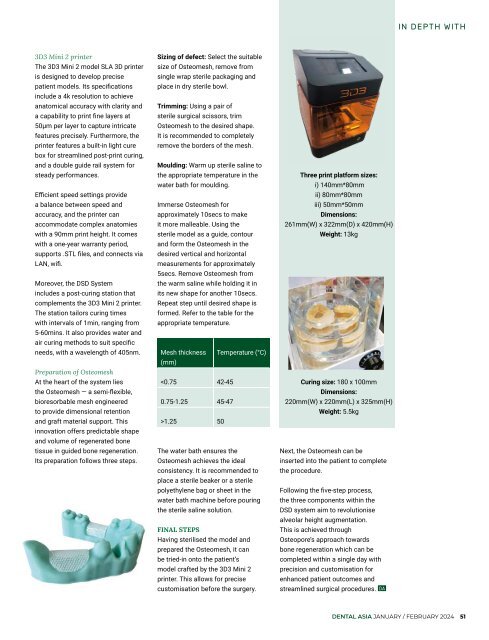Dental Asia January/February 2024
For more than two decades, Dental Asia is the premium journal in linking dental innovators and manufacturers to its rightful audience. We devote ourselves in showcasing the latest dental technology and share evidence-based clinical philosophies to serve as an educational platform to dental professionals. Our combined portfolio of print and digital media also allows us to reach a wider market and secure our position as the leading dental media in the Asia Pacific region while facilitating global interactions among our readers.
For more than two decades, Dental Asia is the premium journal in linking dental innovators and manufacturers to its rightful audience. We devote ourselves in showcasing the latest dental technology and share evidence-based clinical philosophies to serve as an educational platform to dental professionals. Our combined portfolio of print and digital media also allows us to reach a wider market and secure our position as the leading dental media in the Asia Pacific region while facilitating global interactions among our readers.
You also want an ePaper? Increase the reach of your titles
YUMPU automatically turns print PDFs into web optimized ePapers that Google loves.
IN DEPTH WITH<br />
3D3 Mini 2 printer<br />
The 3D3 Mini 2 model SLA 3D printer<br />
is designed to develop precise<br />
patient models. Its specifications<br />
include a 4k resolution to achieve<br />
anatomical accuracy with clarity and<br />
a capability to print fine layers at<br />
50μm per layer to capture intricate<br />
features precisely. Furthermore, the<br />
printer features a built-in light cure<br />
box for streamlined post-print curing,<br />
and a double guide rail system for<br />
steady performances.<br />
Efficient speed settings provide<br />
a balance between speed and<br />
accuracy, and the printer can<br />
accommodate complex anatomies<br />
with a 90mm print height. It comes<br />
with a one-year warranty period,<br />
supports .STL files, and connects via<br />
LAN, wifi.<br />
Moreover, the DSD System<br />
includes a post-curing station that<br />
complements the 3D3 Mini 2 printer.<br />
The station tailors curing times<br />
with intervals of 1min, ranging from<br />
5-60mins. It also provides water and<br />
air curing methods to suit specific<br />
needs, with a wavelength of 405nm.<br />
Preparation of Osteomesh<br />
At the heart of the system lies<br />
the Osteomesh — a semi-flexible,<br />
bioresorbable mesh engineered<br />
to provide dimensional retention<br />
and graft material support. This<br />
innovation offers predictable shape<br />
and volume of regenerated bone<br />
tissue in guided bone regeneration.<br />
Its preparation follows three steps.<br />
Sizing of defect: Select the suitable<br />
size of Osteomesh, remove from<br />
single wrap sterile packaging and<br />
place in dry sterile bowl.<br />
Trimming: Using a pair of<br />
sterile surgical scissors, trim<br />
Osteomesh to the desired shape.<br />
It is recommended to completely<br />
remove the borders of the mesh.<br />
Moulding: Warm up sterile saline to<br />
the appropriate temperature in the<br />
water bath for moulding.<br />
Immerse Osteomesh for<br />
approximately 10secs to make<br />
it more malleable. Using the<br />
sterile model as a guide, contour<br />
and form the Osteomesh in the<br />
desired vertical and horizontal<br />
measurements for approximately<br />
5secs. Remove Osteomesh from<br />
the warm saline while holding it in<br />
its new shape for another 10secs.<br />
Repeat step until desired shape is<br />
formed. Refer to the table for the<br />
appropriate temperature.<br />
Mesh thickness Temperature (°C)<br />
(mm)<br />
1.25 50<br />
The water bath ensures the<br />
Osteomesh achieves the ideal<br />
consistency. It is recommended to<br />
place a sterile beaker or a sterile<br />
polyethylene bag or sheet in the<br />
water bath machine before pouring<br />
the sterile saline solution.<br />
FINAL STEPS<br />
Having sterilised the model and<br />
prepared the Osteomesh, it can<br />
be tried-in onto the patient’s<br />
model crafted by the 3D3 Mini 2<br />
printer. This allows for precise<br />
customisation before the surgery.<br />
Three print platform sizes:<br />
i) 140mm*80mm<br />
ii) 80mm*80mm<br />
iii) 50mm*50mm<br />
Dimensions:<br />
261mm(W) x 322mm(D) x 420mm(H)<br />
Weight: 13kg<br />
Curing size: 180 x 100mm<br />
Dimensions:<br />
220mm(W) x 220mm(L) x 325mm(H)<br />
Weight: 5.5kg<br />
Next, the Osteomesh can be<br />
inserted into the patient to complete<br />
the procedure.<br />
Following the five-step process,<br />
the three components within the<br />
DSD system aim to revolutionise<br />
alveolar height augmentation.<br />
This is achieved through<br />
Osteopore’s approach towards<br />
bone regeneration which can be<br />
completed within a single day with<br />
precision and customisation for<br />
enhanced patient outcomes and<br />
streamlined surgical procedures. DA<br />
DENTAL ASIA JANUARY / FEBRUARY <strong>2024</strong><br />
51

















